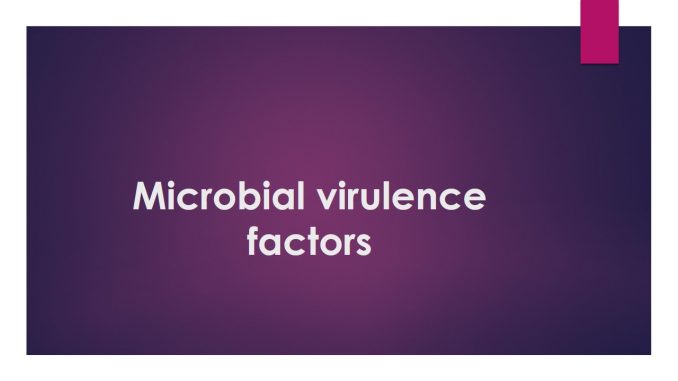
Virulence factors of bacteria; microbial virulence factors
- Virulence factor refers to the components or structure of microorganism that helps in establishment of disease or infection.
- During the process of infection, virulence factors of microorganisms combat with defense mechanism of host. If virulence factors overcome the defense mechanism of host, infection is established otherwise microorganisms are eliminated from host.
- Pathogenicity of microorganism is determined by nature and type of its virulence factors.
Some examples of virulence factors are:
- Attachment factors/ Adhesins
- Anti-phagocytic factors
- Spreading factors and enzymes
- Toxins; exotoxin and endotoxin
1. Attachment factors/ Adhesins:
- Pathogenic microorganisms have structure that helps in attachment of microorganism to skin or mucus membrane to establish infection. Such structural components are known as attachment factors or adhesions.
- Different microorganism utilizes different structure for attachment. For examples; Staphylococcus mutans attaches to the surface of teeth by its sticky capsule. Other bacteria such as coli, Neisseria spp, Shigella attaches with the help of pilli.
Some examples of adhesions are:
- Capsule
- Pili
- Hemagglutinin spike of viruses
- Lipoteichoic acid
- Biofilm producing glycocalyx
2. Antiphagocytic factors:
- Once microorganism enters the body, it is immediately killed by Phagocytic cells of host. In order to survive and cause disease microorganism must resist killing by phagocytosis.
- Capsule is an important antiphagocytic factor for some bacteria. For example capsulated Pneumococcus is virulent and causes pneumonia but non-capsulated Pneumococcus is non-virulent.
- Some other examples of capsulated bacteria are; Haemophilus influenza, Klebsiella pneumonia, Bacillus anthracis,
- Superoxide dismutase and other enzymes: Some bacteria produces superoxide dismutase and other enzyme that prevent from phagocytic killing.
3. Spreading factors and enzymes:
- After infection microorganism needs to spread locally or generally to whole body but host defense mechanism ie blood clot prevent spreading of microorganism.
- Pathogenic microorganisms such as Streptococcus spp produces fibrinolysin that dissolve clot and helps in spread of bacteria.
Examples of spreading factors:
- Fibrinolysin
- Deoxyribonuclease
- Hyaluronidase
- Collagenase
- Protease
4. Toxins:
- Some microorganism produces toxic chemical.
- Toxins are of two types; exotoxin and endotoxin
i. Exotoxin:
- Toxins which are released outside the bacterial cell is called exotoxins
- Exotoxin is protein in nature.
- In general, exotoxins are highly toxic and lethal dose is low.
- Both Gram Positive and Gram Negative bacteria produces exotoxin.
Some examples are:
- Neurotoxin: Botulinum toxin; produced by Clostridium botulinum, tetanus toxin; produced by Clostridium tetani
- Enterotoxin: cholera toxin; produced by Vibrio cholerae, heat stable and heat labile toxin; produced by coli
- Cytotoxin: Dephtheria toxin; produced by Corynebacterium dephtheriae
- Hemolysin: lyse RBCs
- Leucosidin: lyse WBCs
ii. Endotoxin:
- Toxins which are not released outside of bacteria cell is called endotoxin.
- Lipopolysaccharide (LPS) present in outer membrane of Gram Negative bacterial cell wall is an example of endotoxin.
- Endotoxin is less toxic than exotoxin and lethal dose is high.
- Endotoxin causes infection or disease by inducing fever, blood poisoning and septic shock
